Study Notes for Sequential Circuits (Part -2) - Electrical Engineering (EE) PDF Download
1. Registers
When a group of the flip flop is used to store a word (a group of bits) then it is called register. To store n bits, n flip flops are cascaded in the register. If in a register, the binary information can be moved from stage to stage, this type of registers is called shift registers. According to data movement in a register, shift registers can be classified as
- Serial Input Serial Output (SISO)
- Serial Input Parallel Output (SIPO)
- Parallel Input Serial Output (PISO)
- Parallel Input Parallel Output (PIPO)
Serial Input Serial Output (SISO)
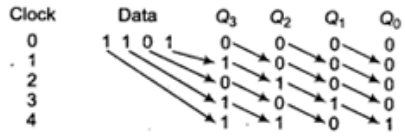
- In registers edge trigger circuit used to make circuit synchronous.
- If no clock is applied then get same data which is stored.
- In N bits SISO registers to provide N bits data, Serially in require N clock pulse, and Serially out require (N-1) clock pulse.
Serial Input Parallel Output (SIPO)
- To provide N-bit data: Serial in requires N clock pulse, and Serial out requires no clock pulse.
- SISO can provide n × tCIK delay to the input.
- SISO can convert serial data or temporal code to parallel or serial code.
Parallel Input Serial Output (PISO)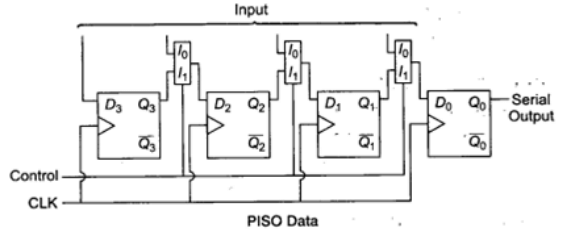
- If control = 0 then it acts as parallel input;
- If control = 1 then it acts as serial output;
- To provide parallel input, one clock pulse is required.
- To provide N bits serial output, it requires (N-1) clock pulse.
- PISO can convert special code to temporal code.
Parallel Input Parallel Output (PIPO)
- In PIPO register for parallel input number of pulse required is 1 clock pulse.
- In PIPO register for parallel output number of pulse required is 0 clock pulse.
- PIPO register cannot be used as a shift register.
- It is used for temporal storage of data in microcontroller, DSP, CPU etc.
Summary of Registers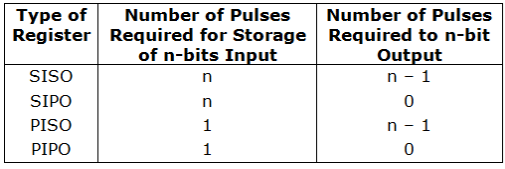
2. Counter
- A counter is a sequential logic circuit capable of counting the number of clock pulses arriving at its clock input.
- The sequence of count may be ascending, descending or non-sequence.
- For a counter circuit having n flip flops, Maximum possible states (N) = 2n
- If N = 2n, the counter acts as a binary counter.
- If N < 2n , the counter the non-binary counter.
- It counter is capable to count from 0 to 2n-1.
- MOD number is the Number of states present in a counter is known as modulus count or MOD number.
- For n-flip flops, the counter will have 2n different states then this counter is said MOD- 2n counter.
MOD-N Counter
- MOD number indicates frequency division obtained from the last flip flops.

- Cascaded two counters:

- MOD-MN counter:
Overall states of combined counter = MN
Input frequency = f
Output frequency f = f/(MN)
3. Classification of Counters
Based upon the applying clock pulse, counters are classified into two categories.
- Synchronous counter
- Asynchronous counter (ripple counter)
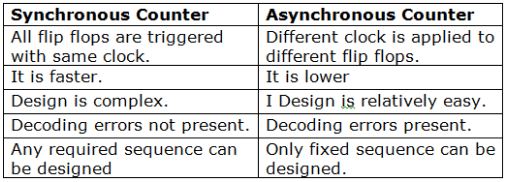
4. Toggle Mode Circuit
These are frequency dividers circuit.
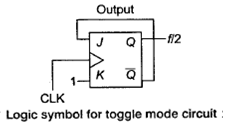
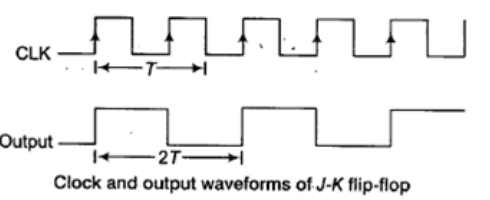
Other Toggle Mode Circuit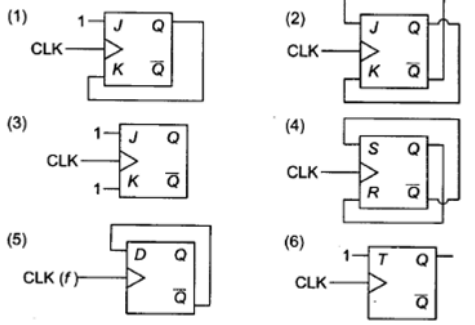
5. Asynchronous Counter (Ripple counter)
- A different clock pulse is applied to different flip flops.
- All flip flops are operating in toggle mode.
- In asynchronous counter flip flop applied with external clock acts as LSB bit.
3-bit Ripple Up Counter
- Input clock is applied at LSB bit.
- It n-bit ripple counter maximum possible states are 2n.
- Bit ripple up counter counts from 0 to 2n - 1.
- If all states are used then with input frequency f, then output frequency will be f/2n
- Calculation of Time Period of Flip Flop: In n-bit ripple counter if propagation delay of each flip flop is tpd(FF), then the time period of the clock is:
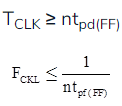
- Maximum Clock Frequency

- Due to propagation delays of flip flops decoding errors are present.
- Clear and preset are known as asynchronous input to flip flop.
- In any ripple counter, the following conditions will fulfil
Negative edge trigger and Q as clock ⇒ up counter
Positive edge trigger and Q as clock ⇒ up counter
3-bit Ripple Down Counter

- Positive edge trigger and Q as clock ⇒ down counter
- Negative edge trigger and Q as clock ⇒ down counter
Non-binary Ripple Counter
Decode counter or BCD counter is an example of a non-binary counter. It requires 4 flip flops.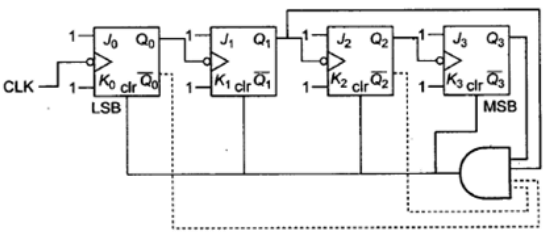
- Used state = 10 and unused states = 6 → (24 -10)
- Output frequency of BCD counter = f/10
- For making non-binary counter clear (clr) signal is used.
- c1r is active high, and (clr)' is active low.
6. Synchronous Counters
In this type of counter, there are no connections of first flip flop output to a clock input of the next flip flop.
Ring Counter: It is a circular shift register with only flip flop being set at any particular time, all others are cleared. It is a shift register with feedback.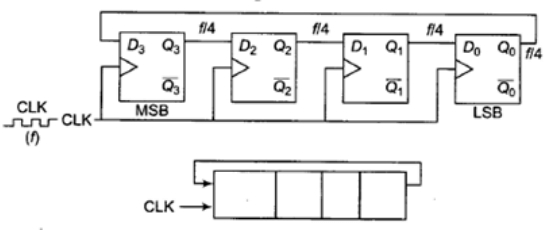
- In ring counter, if feedback is used the number of states is reduced.
- With n flip flops maximum states = n.
- Number of unused states in ring counter = 2n – n
- Maximum Clock Frequency: If input frequency is f, then at the output of every flip flop we get f/N frequency. In ring counter, if propagation delay of each flip flop is tpd(FF) then
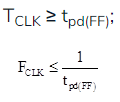
Jhonson Ring Counter: Jhonson ring counter is also called as a Twisted ring counter, Switch tail counter, Creeping counter, or Mobies counter.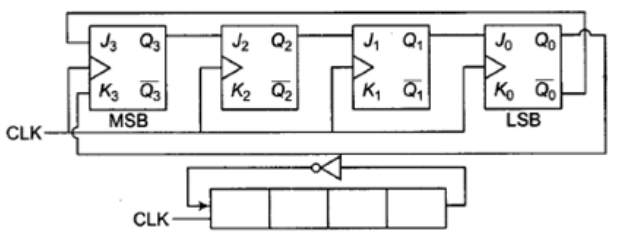
- In n - bit Jhonson counter maximum used states = 2n, unused states = 2n - 2n.
- If input clock frequency is f, the output frequency of each flip flop is f /2n and the duty cycle is 50%.
- A disadvantage of Jhonson Ring Counter: Lockout may occur. To decode each state one, two input AND or NOR gate is used.













